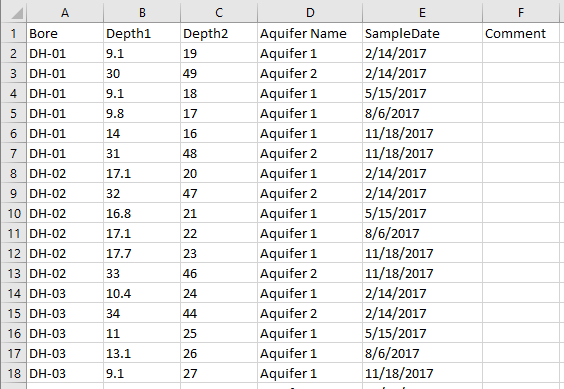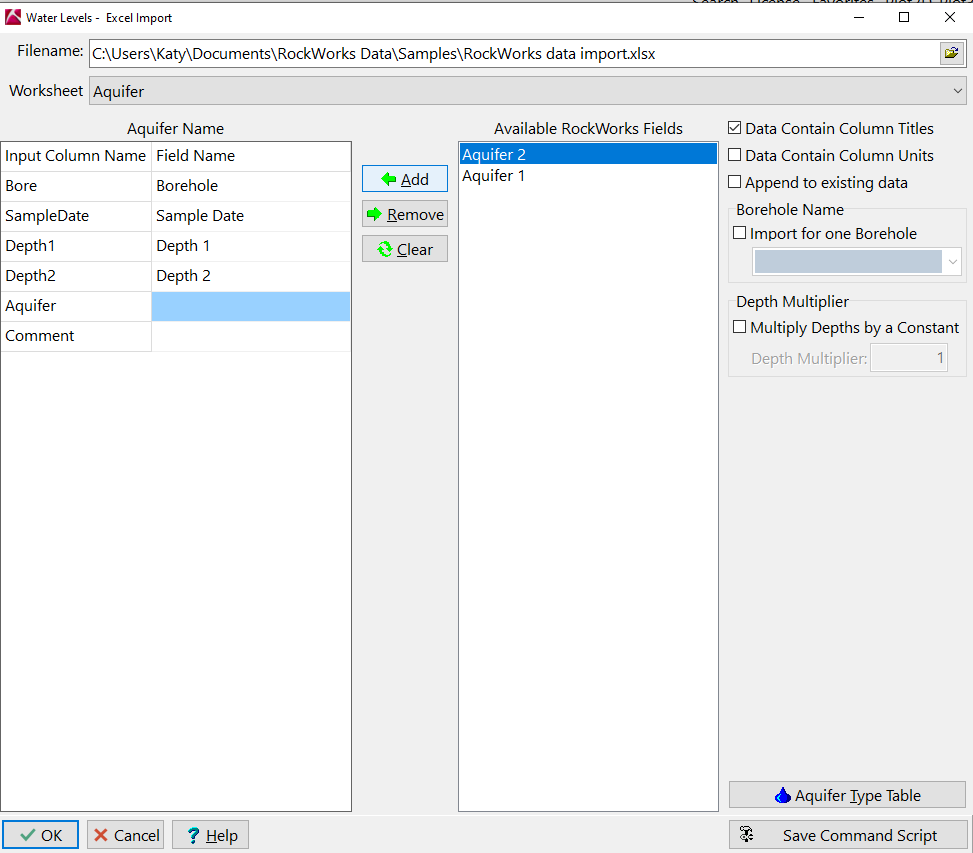Borehole Manager | File | Import | Excel | Single Table | Aquifer Data
Borehole Manager | File | Import | Text | Single Table | Aquifer Data
These Borehole Manager programs are used to read row and column data from a single worksheet in Excel file or from a single text (CSV, tab-delimited) file, and import the rows and columns into the Aquifer table for a single borehole. This is primarily designed for users who have elevation or depth measurements for multiple units, which can't be easily brought into the RockWorks database using the Row Based Excel import. This import works with XLSX, XLS, CSV, and TXT files, provided that Microsoft Excel is installed on the user's machine.
Here is an example of the kind of data that can be brought into RockWorks using this program; this subset lists the borehole ID in the first column, and Aquifer names and depths in the subsequent columns.

! This program allows you to either append new data from Excel to existing aquifer data in RockWorks, or to replace all existing data.
Menu Options
Step-by-Step Summary
- Filename: Click on the small open-file button to browse for the name of the Excel file (XLSX or XLS) or CSV (CSV or TXT) that contains the data to be imported.
- Worksheet: If you are importing from XLSX or XLS, select the name of the worksheet in the Excel file that contains the row and column data. When you select this, the program should display data information in the list below "Input Column Name". (If you are importing from CSV or TXT this step is not necessary.)
- Change Delimiter: If you are importing from CSV, you can use this button to define a different column delimiter for the input file.
- Data Contain Column Titles: This setting, on the right side of the Import window, allows you to define if the worksheet contains an uppermost row that contains the name of each data column, as in the "Name", "Aquifer Name", "Depth1" and other items in the example above. If checked, these names will appear under the "Input Column Name" listing to the left. If unchecked, the column names will be set to the more generic "Column 1", "Column 2", etc.
- Data Contain Column Units: This setting allows you to define if the worksheet contains a second row in which the units are defined for certain columns, such as feet or meters for depths. This tells the program to ignore the second row and begin data import with the 3rd.
- Append to existing data: If checked, RockWorks will append the new data to any existing data in the Aquifer table. If not checked, all data will be replaced with the data being imported.
- Import for one Borehole: Here you can specify whether the import data is for a single borehole or for multiple holes.
- Check this box to select the name of the existing borehole to which the aquifer data is to be recorded.
- Leave this box unchecked if the data will be imported to multiple holes.
! This requires that there be a column in the spreadsheet that lists the borehole name.
! The borehole names in the spreadsheet must match the borehole names which already in the RockWorks project database.
- Input Column Name: This list, along the left, should contain all of the columns in your spreadsheet, either in a "Column 1", "Column 2" format (the Data Contain Column Titles option is not checked) or listing your actual column titles (the Data Contain Column Titles option is checked).
- Available RockWorks Fields: In this area you will see the names of the aquifers which you have already defined for your project, in the Aquifer Names table.
! If your aquifers are not listed here, click the Aquifer Names button to define these at this time. (See Aquifer Names Table for more information.)
Your job here is to map the columns: For each selected worksheet Column Name, choose the aquifer in the current database where the column is to be imported. You can either click and drag the Available RockWorks Fields to the column names on the left using your mouse, or you can click on the respective items and use the Add button to do the mapping.

- If you have specified that data for multiple boreholes is being imported (and the Import for One Borehole option is not checked), be sure that you map the spreadsheet column containing the Borehole ID to the database field named Borehole.
- Be sure the borehole(s) to which the data is to be imported already exists in the project database. You can't post Aquifer data to a borehole if it doesn't yet exist.
- If you don't have Aquifer names established at this time, you can click the Aquifer Type Table, at the bottom of the window to create your Aquifer names.
- Depth Multiplier: Use this setting to convert depth units as necessary. For example, if your database elevations and depths are in meters, but the import units are in feet, you can check this box and type in: 0.3048 so that the units will match.
- Access the RockWorks Borehole Manager program tab.
- If necessary, browse to the project folder in which you want to work.
- Be sure that the borehole(s) to which you wish to import the spreadsheet data to already exist in the project.
- Be sure that the spreadsheet you want to import complies with the row and column format described above, with data for each borehole on a single row and aquifer name, depths, date, and comments listed in columns. If you are importing for multiple holes at this time, the borehole name must be listed in one of the columns.
- Select the File | Import | CSV | Column Based | Aquifer menu option to import from CSV.
Select the File | Import | Excel | Column Based | Aquifer menu option to import from XLS or XLSX.
- Select the name of the XLS or CSV file to be imported. The program will scan the file and load the names of the columns in the Input Column Name listing.
- If you are importing from XLS you can use the Worksheet field to choose a different worksheet from the file.
- If the input data does not contain column titles, uncheck the Data Contain Column Titles checkbox on the right.
- Next, specify whether you are importing for a single borehole or for multiple holes using the Import for One Borehole checkbox (as described above).
- If you need to define the Aquifer names for your project boreholes (or add to existing names) click the Aquifer Type Table button and make the necessary changes to the Aquifer Type table.
- Map the project's Aquifers to the spreadsheet columns, as described above. Be sure to map the borehole name column to the Borehole ID field.
- Click the OK button to proceed.
The program will read the specified XLSX, XLS, CSV, or TXT file. It will extract the data from the requested data columns and map them to the indicated database fields for the indicated boreholes.
 Back to Import Data
Back to Import Data

RockWare home page



![]() Back to Import Data
Back to Import Data